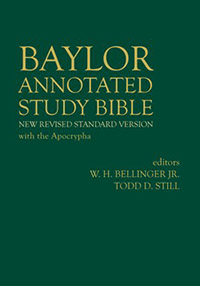Baylor Annotated Study Bible
Edited by W.H. Bellinger Jr. and Todd Still
For decades, the Oxford Annotated Bible and then the New Oxford Annotated Bible were favored by ministry and theology schools. There is now a contender.
 The idea for the Baylor Annotated Study Bible originated when a former director of the Princeton University Press told the former director of the Baylor University Press that Baylor ought to produce its own study Bible. That was in 2014. Five years later, the Baylor Annotated Study Bible, or BASB as it already is commonly known, was published.
The idea for the Baylor Annotated Study Bible originated when a former director of the Princeton University Press told the former director of the Baylor University Press that Baylor ought to produce its own study Bible. That was in 2014. Five years later, the Baylor Annotated Study Bible, or BASB as it already is commonly known, was published.
Leading the project were Old Testament scholar William Bellinger Jr., chair of Baylor’s religion department, and New Testament scholar Todd Still, dean of Baylor’s Truett Theological Seminary.
Like the Oxford Bible, the BASB uses the New Revised Standard Version, which is approved by a wide array of Christian denominations. In keeping with this ecumenical spirit, not all of the contributors are Baptist, but all have a connection to Baylor, whether as faculty or alumni or as friends of the university, seminary or press.
Roughly 70 pastors and scholars contributed to the BASB, writing introductions to each of the books of the Bible and commentary notes. Contributors include world-renowned scholars like N.T. Wright, Richard Hays, Scot McKnight and Walter Brueggemann; Texas Baptist pastors like Howie Batson at First Baptist Church in Amarillo and Duane Brooks at Tallowood Baptist Church in Houston; Houston Baptist University President Robert Sloan; and even an attorney, Mark Lanier.
Also like the Oxford Bible, the BASB’s notes appear at the bottom of the page to be easily accessible to the reader without interrupting the reading of Scripture.
“(The notes) are there to help readers read. They’re not there to discuss scholarship. They are notes that will help readers read the text for all its worth,” said Carey Newman, former director of the Baylor University Press.
Further resources included in the BASB are a detailed timeline of biblical history “against the backdrop of ancient Near Eastern and Greco-Roman history;” a glossary of “terms and names mentioned in the introductions, commentaries and timeline;” a concordance with tables for the miracles and parables of Jesus; and full-color maps.
In addition to enlisting dozens of well-respected contributors, Baylor partnered with Tyndale House Publishers to publish the BASB. Tyndale’s capabilities in Bible publishing allow “individuals, churches and other organizations to order specially bound and burnished versions of the BASB.”
Sign up for our weekly edition and get all our headlines in your inbox on Thursdays
The intent of the BASB is spelled out in the Editor’s Preface: “The aim of the roughly seventy contributors to the BASB is to assist readers in following the literary flow of a given biblical book; gaining a better understanding of certain aspects of a writing; appreciating the socio-historical context(s) in(to) which the work was written; noting connections with other biblical and ancient literary works; and considering the theological concerns and claims of the authors.”
“The BASB is meant for both personal and classroom study and seeks to follow in the long-standing mission of Baylor University, namely, to serve as a faithful witness to the liberating, transformative good news of the gospel,” Todd Still stated.
Eric Black
Editor
Baptist Standard














We seek to connect God’s story and God’s people around the world. To learn more about God’s story, click here.
Send comments and feedback to Eric Black, our editor. For comments to be published, please specify “letter to the editor.” Maximum length for publication is 300 words.